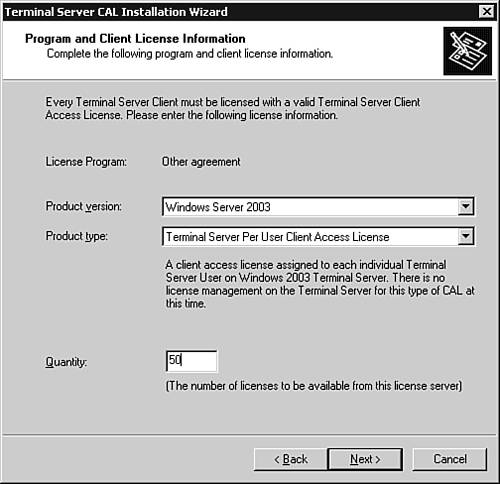How To Crack Windows Server 2003 Terminal Service Licensing

You can enable 'administrative mode' terminal services, which allows only two sessions, via the System Control Panel applet's Remote tab; for full terminal services, you must enable it by performing these steps: • Start the Add or Remove Programs Control Panel applet (Start - Settings - Control Panel - Add or Remove Programs). • Click Add/Remove Windows Components. • Select the Terminal Server option (and clear Internet Explorer Enhanced Security Configuration), then click Next. • For the security mode, select Full or Relaxed, then click Next. • Select the licensing server to use or select the option to automatically discover a license server, as the shows, then click Next. • Select the licensing mode--Per Device or Per User. If you have more users then devices, select Per Device mode; otherwise select Per User.

Click Finish. • Reboot the computer when prompted.
Terminal Server implementation will require both client and server licenses. Licenses Required for Each Terminal Server. Microsoft requires one license for each server in a Terminal Services environment. This license, known as a “server license,” is just the standard Windows Server 2003 license—you. Jan 21, 2013 Instructions 1 Restart the Windows Server 2008 computer, and log in to a Windows. Aug 06, 2013 Windows 2003 Terminal Server Licensing Hack / Bug In Windows 2000, Terminal Services only included. Masih menggunakan windows server 2003 dan di upgrade.
You must add all users who you want to be able to connect to the terminal server to the Remote Desktop Users group, and you must install all programs via the Add or Remote Programs Control Panel applet. Members of a terminal server farm must be running Windows 2003 Enterprise Edition. If you want to confirm the licensing server that a terminal server is using, run the lsview.exe utility, which you'll find in the Windows 2003 Resource Kit. The shows the results of running the tool. You can also see the licensing server by navigating to the HKEY_LOCAL_MACHINE SOFTWARE Microsoft MSLicensing Parameters registry key under either the EnterpriseServerMulti or DomainLicenseServerMulti values (depending on the type of the licensing server).
HOW TO RESET WINDOWS TERMINAL SERVICES 3 MONTH TRIAL Warning: greyhat content. Thanks to a Microsoft article, I've found out that it is very easy to extend your Windows Terminal Services 3-month trial or experience time. It's so easy that I'm sure many administrators have done this in their own systems, while waiting for their managers or financial staff to buy the definitive licenses (not being hypocrite here). Following these instructions, you don't have to crack any program.
You won't mess with your system. The magic is to only delete the licenses databases both in the server and the clients, and let windows re-create them for you. ---- Make sure you've installed 'Terminal Services Licensing'. By the way, this method only makes sense if you need to use Terminal Services in Application Mode, which is the one that requires licensing. The idea is quite simple. First, disconnect all users from the terminal.
If you need to do this remotely, you can also disconnect yourself, and access the files remotely. Go to%WINDIR% system32 lserver Notice the file TSLIC.edb. Rename it to tslic.old In every client computer, remove the CAL TS registry keys, located at: HKEY_LOCAL_MACHINE SOFTWARE Microsoft MSLicensing Restart your server. Finally, if you need more information about how to crack terminal services, See the 'Cause 2' steps.:-) Shouldn't MS improve the security for TS Licensing in the next versions of Windows (2003 with SP1 is also easy to 'crack')?
Dell Battery Calibration Download. PS>I am definitely against software piracy. I strongly believe that Microsoft should strength their anti-piracy policy. Only then they could theoretically lower their licensing prices. The biggest result, though, would be a huge increase of free software popularity. Only then we, FOSS proponents, would have the opportunity to prove our paradigm is superior (now I'm being hypocrite, I guess). UPDATE: Since Windows 2003, instead of following the complex process above, you can just switch to 'Per User' mode.